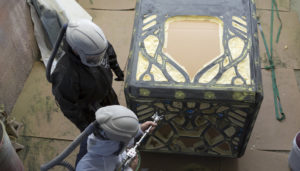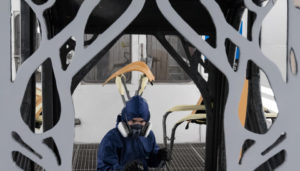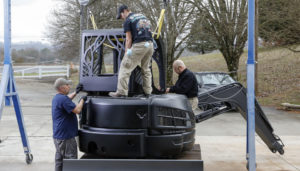 There’s 3D printed Lego construction equipment…and then there’s Project AME, the first fully functional, full-size 3D printed excavator in the world. We have been following Project AME’s progress for nearly a year: AME stands for Additive Manufactured Excavator, and was developed as a joint collaboration between Oak Ridge National Laboratory (ORNL), the Association of Equipment Manufacturers (AEM), National Fluid Power Association (NFPA), the Center for Compact and Efficient Fluid Power (CCEFP), and the National Science Foundation (NSF). Research teams of graduating engineering students from the University of Illinois at Urbana-Champaign (UIUC), the University of Minnesota, and Georgia Tech also worked on Project AME.
There’s 3D printed Lego construction equipment…and then there’s Project AME, the first fully functional, full-size 3D printed excavator in the world. We have been following Project AME’s progress for nearly a year: AME stands for Additive Manufactured Excavator, and was developed as a joint collaboration between Oak Ridge National Laboratory (ORNL), the Association of Equipment Manufacturers (AEM), National Fluid Power Association (NFPA), the Center for Compact and Efficient Fluid Power (CCEFP), and the National Science Foundation (NSF). Research teams of graduating engineering students from the University of Illinois at Urbana-Champaign (UIUC), the University of Minnesota, and Georgia Tech also worked on Project AME.
The excavator, a prototype to demonstrate what’s possible in terms of large-scale additive materials technologies, proved without a doubt that it is feasible to 3D print with metal alloys, and was finally unveiled and demonstrated yesterday at CONEXPO-CON/AGG (aptly themed Imagine What’s Next) and IFPE 2017 in Las Vegas.
 Project AME was funded by the Department of Energy’s Office of Energy Efficiency and Renewable Energy – Advanced Manufacturing Office (AMO), which supports development, applied research, and demonstration of new processes and materials for energy efficient manufacturing. All of the university students, industry partners, and ORNL researchers worked together, in order to design and fabricate Project AME, which is the first large-scale use of steel in a 3D printing application. The project was a learning experience, not only for the students, but also for the researchers and engineers who work with additive manufacturing all the time.
Project AME was funded by the Department of Energy’s Office of Energy Efficiency and Renewable Energy – Advanced Manufacturing Office (AMO), which supports development, applied research, and demonstration of new processes and materials for energy efficient manufacturing. All of the university students, industry partners, and ORNL researchers worked together, in order to design and fabricate Project AME, which is the first large-scale use of steel in a 3D printing application. The project was a learning experience, not only for the students, but also for the researchers and engineers who work with additive manufacturing all the time.
Lonnie Love, group leader of ORNL’s Manufacturing Systems Research Group, said, “The beauty of a project of this size and scope is that it brings together many intelligent people to work on a number of challenges while accomplishing a common goal.”
 Love directed the student research teams while they worked to adapt a basic compact excavator design and create plans to additively manufacture the excavator’s cab (its Voronoi design was developed by UIUC students), hydraulic oil reservoir, cooling system, hydraulically articulated work arm (also known as the stick), heat exchanger, bucket, and boom.
Love directed the student research teams while they worked to adapt a basic compact excavator design and create plans to additively manufacture the excavator’s cab (its Voronoi design was developed by UIUC students), hydraulic oil reservoir, cooling system, hydraulically articulated work arm (also known as the stick), heat exchanger, bucket, and boom.
The engineering students from UIUC won a contest to design the excavator’s cab, and had the opportunity to actually see their designs being built, in person, on the large-scale 3D printing equipment at the Department of Energy’s Manufacturing Demonstration Facility (MDF), which is housed at ORNL.
“While hundreds of people, many of whom are students, visit the MDF each year, this is the first student group to watch their design 3D printed on one of our large-scale machines. We’re also exposing them to the possibilities that additive manufacturing is affording industry that can help companies from so many different areas whether it’s automotive, construction or other applications yet to be discovered,” said Love.
 Love spoke to the crowd at the expo yesterday about how 3D fabrication will continue to benefit the construction industry in the future, and what can be accomplished by working together to develop new ideas for the industry.
Love spoke to the crowd at the expo yesterday about how 3D fabrication will continue to benefit the construction industry in the future, and what can be accomplished by working together to develop new ideas for the industry.
“Trade associations like the Association of Equipment Manufacturers and the National Fluid Power Association help to foster collaboration and innovation between people and companies inside our respective industries. Project AME should be held up as an example of what can be accomplished when we are able to bring together competitors to innovate ideas for the betterment of the industry as a whole,” Love said.
 Different 3D printing materials, platforms and machines (like the Wolf System), and processes were used to build the functional excavator, which is a working demonstration of the “wide range of industrial applications for 3D printing.”
Different 3D printing materials, platforms and machines (like the Wolf System), and processes were used to build the functional excavator, which is a working demonstration of the “wide range of industrial applications for 3D printing.”
John Rozum, IFPE show director, said, “We’re thrilled to bring such a significant technological and first-of-its-kind achievement like the 3D printed excavator to ConExpo; it will be a platform to demonstrate how the latest innovations and applied technologies are changing the future of the construction industry.”
If you’re at the expo this week, you can stop by the new Tech Experience to check out Project AME for yourself. You can also check out the Project AME overview video below:
Discuss in the ORNL forum at 3DPB.com.
[Sources: Construction Equipment, CONEXPO-CON/AGG, ORNL / Images: ORNL]
Subscribe to Our Email Newsletter
Stay up-to-date on all the latest news from the 3D printing industry and receive information and offers from third party vendors.
You May Also Like
3D Printing Unpeeled: New Arkema Material for HP, Saddle and Macro MEMS
A new Arkema material for MJF is said to reduce costs per part by up to 25% and have an 85% reusability ratio. HP 3D HR PA 12 S has been...
3D Printing News Briefs, January 20, 2024: FDM, LPBF, Underwater 3D Printer, Racing, & More
We’re starting off with a process certification in today’s 3D Printing News Briefs, and then moving on to research about solute trapping, laser powder bed fusion, and then moving on...
3D Printing Webinar and Event Roundup: December 3, 2023
We’ve got plenty of events and webinars coming up for you this week! Quickparts is having a Manufacturing Roadshow, America Makes is holding a Member Town Hall, Stratafest makes two...
Formnext 2023 Day Three: Slam Dunk
I’m high—high on trade show. I’ve met numerous new faces and reconnected with old friends, creating an absolutely wonderful atmosphere. The excitement is palpable over several emerging developments. The high...



































